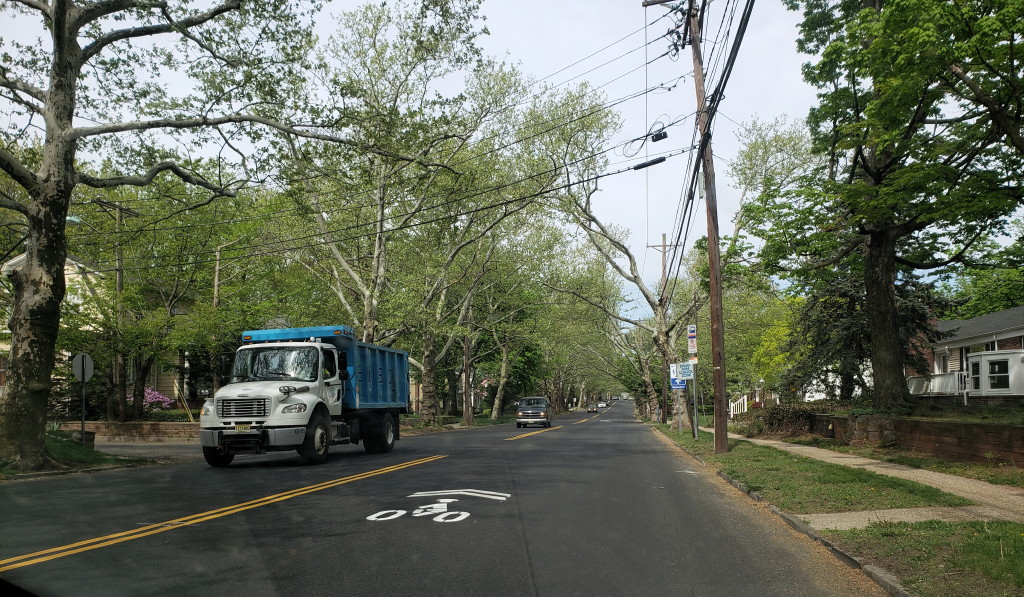METUCHEN – When Alan Johnson rides his bike on Main Street in Metuchen, he sometimes does not feel safe.
“It’s kind of like the chicken and egg,” he said. “We have the bikes, we need the infrastructure to make it safer and productive to get around.”
Johnson, a member of the Traffic and Transportation Committee, expressed his thoughts at a Metuchen Borough Council meeting on May 28.
Evan Seiler, also a member of the Traffic and Transportation Committee, presented the committee’s proposed three-phase plan of a bike network for the borough.
He reported that the committee has reviewed all the studies supporting bike infrastructure improvements, including a Circulation Plan in 2009, Complete Streets Policy in 2013, Downtown Parking in 2014, Middlesex Greenway Access Plan and Health Impact Assessment in 2014, Accessibility Evaluation in 2015, a School Travel Plan in 2016, and a Complete Streets Bicycle and Pedestrian Plan in 2016.
Seiler explained that the committee also has reviewed real-world data from LimeBike riders. In May 2018, council members authorized a one-year pilot program contract with LimeBike, a San Mateo, California, tech mobility company. There is no cost to Metuchen. The roll out included 50 bikes and now includes 10 e-bikes.
In the past nine months, there have been 1,967 riders, who have taken 5,769 rides over 6,030 miles and 123,826 minutes, he said.
Existing bike infrastructure improvements include a bike path at the Middlesex Greenway from Middlesex Avenue to the town border; sharrows on Middlesex, Lake and Essex avenues; sharrows from Amboy Avenue to Lake Avenue to the town border; and a walking and bike path at Myrtle Fields.
Phase one of the three-phase proposal includes the implementation of a protected bike lane from Grove Avenue to Woodbridge Avenue to the town border; a protected cycle track from Oakland Avenue to Grove Avenue to the town border; a bike boulevard from Highland Avenue to Grove Avenue to Robins Place to Hillside Avenue; sharrows on Hillside Avenue and New Street; a protected bike lane from Central Avenue to Lake Avenue to the town border; a two-way cycle track from Plainfield Avenue to Central Avenue to Main Street; and a bike boulevard to Christol Street to Main Street to Grove Avenue.
Two-way cycle tracks are physically separated cycle tracks that allow bicycle movement in both directions on one side of the road.
A bike boulevard is a street with low motorized traffic volumes and speeds, designated and designed to give bicycle travel priority. It uses signs, pavement markings and speed and volume management measures to discourage through trips by motor vehicles and create safe, convenient bicycle crossings of busy arterial streets.
Sharrows are line markings in the middle of motor vehicle lanes that indicate the road needs to be shared by vehicles and bicyclists
Seiler said that another option is a shared sidewalk, which he said they will try to avoid as much as possible. In some cases a sidewalk is wide enough to accommodate cyclists and pedestrians, where a shared sidewalk can be implemented.
Phase two includes a protected bike lane from Durham Avenue to Central Avenue to the town border; a cycle track at the former Oakite property; a bike boulevard from Clive Street and Mason Drive to Main Street to Grove Avenue; a bike boulevard from Carson Road and Bissett Place connecting Woodbridge Avenue and Amoy Avenue to the Metuchen Forum Theater; and a two-way cycle track for the entire length of Lake Avenue.
Phase three includes a bicycle boulevard on Brunswick Avenue and Myrtle Avenue between Lake Avenue and Myrtle Park; a Myrtle and Greenway Bridge connecting south east to Greenway and downtown; and a Highland Boulevard Extension and Centennial Park bike path connecting a previously cut off area to the Highland Bike Boulevard and downtown.
Seiler said the next steps include seeking professional assistance, vetting suggested routes, confirming the phased roll out plan, providing cost estimates for each phase and finalizing selected roadway treatments.
Also, the next steps include adopting a bicycle operations ordinance and seeking grant funding where needed.
Councilman Todd Pagel reported that the committee is at the point where members have exhausted all previous studies and they know where the bike routes need to go, they just need engineering guidance on how to implement them; for example, how wide the protected bike lane should be on Grove Avenue, what kind of paint should be used, and where residents should put their trash cans, he said.
Councilman Jason Delia suggested that bringing in a consulting firm specializing in bike lanes, which could give the borough a holistic view on the committee’s suggested proposal. He said that once the committee receives the engineering and cost aspects of the proposal, it will help them make their case for grant funding.
Mayor Jonathan Busch revealed that the proposal is full of all great ideas. As for a timeline, he said that the implementation of the proposal would be a long-term commitment for the borough due to timings of grant monies coming in, and a tight municipal budget.
“We’re doing a good job managing [the municipal budget], but there’s zero fluff balancing other priorities,” he said.
Tom Rockafeller, a member of the Traffic and Transportation Committee, said in the meantime, borough officials could move forward on the bike operations ordinance and continue to seek grant funds.
Contact Kathy Chang at [email protected].

